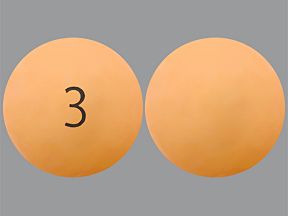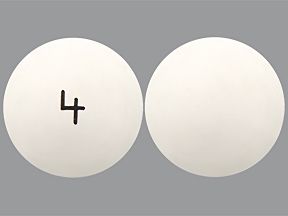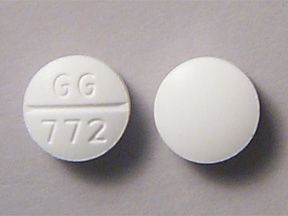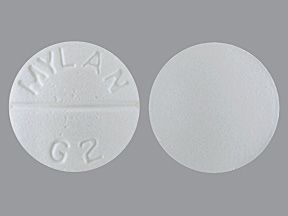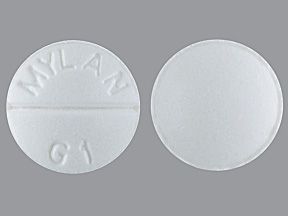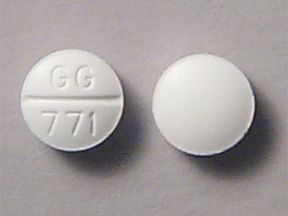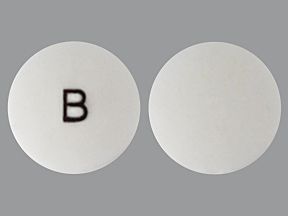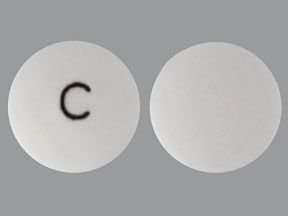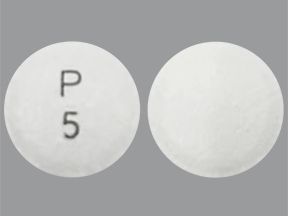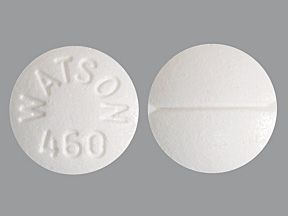Highlights for glipizide
- Glipizide oral tablet is available as both a generic and brand-name drug. Brand names: Glucotrol and Glucotrol XL.
- Glipizide comes in the form of an immediate-release tablet and an extended-release tablet.
- Glipizide is used to treat type 2 diabetes.
Glipizide is an oral prescription drug. It comes as an oral immediate-release tablet and oral extended-release tablet.
Glipizide oral tablet is available as the brand-name drugs Glucotrol and Glucotrol XL. It’s also available as a generic drug. Generic drugs usually cost less. In some cases, they may not be available in every strength or form as the brand name versions.
Why it’s used
Glipizide is used to reduce blood sugar levels in people with high blood sugar caused by type 2 diabetes.
How it works
Glipizide belongs to a class of drugs called sulfonylureas. A class of drugs refers to medications that work similarly. They have a similar chemical structure and are often used to treat similar conditions.
Glipizide helps release insulin from your pancreas. Insulin moves sugar from your bloodstream to your cells, where it belongs. This decreases your blood sugar levels.
Glipizide oral tablet doesn’t cause drowsiness, but it can cause other side effects.
More common side effects
The more common side effects that can occur with glipizide tablets include:
- low blood sugar
- digestive problems such as nausea, diarrhea, or constipation
- weight gain
- dizziness
- skin rash
- sweating
- fast heart rate
Serious side effects
Call your doctor right away if you have serious side effects. Call 911 or your local emergency services if your symptoms feel life-threatening or if you think you’re having a medical emergency. Serious side effects and their symptoms can include the following:
- Low blood sugar. Symptoms can include:
- intense hunger
- nervousness
- shakiness
- sweating, chills, and clamminess
- dizziness
- fast heart rate
- lightheadedness
- sleepiness
- confusion
- blurred vision
- headache
- depression
- irritability
- crying spells
- nightmares and crying out in your sleep
- Allergic reaction. Symptoms can include:
- red, itchy, or dry skin
- skin rashes
- Low blood cell or platelet counts. Symptoms can include:
- infections
- bleeding that doesn’t stop as quickly as normal
- Low blood sodium levels. Symptoms can include:
- nausea
- vomiting
- headache
- confusion
- fatigue
- muscle weakness
- seizures
- coma
- Liver problems. Symptoms can include:
- yellowing of your skin and the whites of your eyes (jaundice)
- stomach pain and swelling
- swelling in your legs and ankles (edema)
- itchy skin
- dark-colored urine
- pale stool or tar-colored stool
- always feeling tired
- nausea
- vomiting
- bruising easily
Disclaimer: Our goal is to provide you with the most relevant and current information. However, because drugs affect each person differently, we cannot guarantee that this information includes all possible side effects. This information is not a substitute for medical advice. Always discuss possible side effects with a healthcare professional who knows your medical history.
Glipizide oral tablet can interact with other medications, herbs, or vitamins you might be taking. That’s why your doctor should manage all of your medications carefully. If you’re curious about how this drug might interact with something else you’re taking, talk with your prescribing doctor or pharmacist.
Note: You can reduce your chances of drug interactions by having all of your prescriptions filled at the same pharmacy. That way, a pharmacist can check for possible drug interactions.
Examples of drugs that can cause interactions with glipizide are listed below.
Nonsteroidal anti-inflammatory drugs (NSAIDs)
These drugs can cause low blood sugar when taken with glipizide. Examples of these drugs include:
- ibuprofen
- naproxen
- diclofenac
Antifungal medications
These drugs can cause low blood sugar when taken with glipizide. Examples of these drugs include:
- fluconazole
- miconazole
- ketoconazole
Drugs that contain salicylate
These drugs can cause low blood sugar when taken with glipizide. Examples of these drugs include:
- aspirin
- salsalate
Drugs that contain a sulfonamide
These drugs can cause low blood sugar when taken with glipizide. Examples of these drugs include:
- sulfacetamide
- sulfadiazine
- sulfamethoxazole/trimethoprim
Blood thinner medication
Warfarin can cause low blood sugar when taken with glipizide.
Depression drugs
Monoamine oxidase inhibitors (MAOIs) can cause low blood sugar when taken with glipizide. Examples of these drugs include:
- isocarboxazid
- phenelzine
Selective serotonin reuptake inhibitors (SSRIs), such as fluoxetine, may also cause low blood sugar when given with glipizide.
Heart and blood pressure medications (beta-blockers)
These drugs can cause low blood sugar when taken with glipizide. Examples of these drugs include:
- metoprolol
- atenolol
Hormones
Certain types of hormones may increase your blood sugar levels when taken with glipizide. Be sure to test your blood sugar as directed by your doctor if you’re taking these medications together. Examples of these drugs include:
- danazol
- somatropin (growth hormone)
- glucagon
- oral birth control pills
- estrogens
Drugs used to treat HIV
These drugs may increase your blood sugar levels when taken with glipizide. Be sure to test your blood sugar as directed by your doctor if you’re taking these medications together. Examples of these drugs include:
- amprenavir
- atazanavir
- darunavir
- fosamprenavir
Adrenergic drugs
These drugs may increase your blood sugar levels when taken with glipizide. Be sure to test your blood sugar as directed by your doctor if you’re taking these medications together. Examples of these drugs include:
- albuterol
- epinephrine
- terbutaline
Diuretics (thiazide diuretics)
These drugs may increase your blood sugar levels when taken with glipizide. Be sure to test your blood sugar as directed by your doctor if you’re taking these medications together. Examples of these drugs include:
- chlorothiazide
- chlorthalidone
- hydrochlorothiazide
Corticosteroids
These drugs may increase your blood sugar levels when taken with glipizide. Be sure to test your blood sugar as directed by your doctor if you’re taking these medications together.
Anti-psychotic, anti-nausea, and anti-vomiting medications
These drugs may increase your blood sugar levels when taken with glipizide. Be sure to test your blood sugar as directed by your doctor if you’re taking these medications together. Examples of these drugs include:
- chlorpromazine
- promethazine
- prochlorperazine
- olanzapine
- clozapine
- phenothiazines
- reserpine
Heart and blood pressure medications
These drugs may increase your blood sugar levels when taken with glipizide. Be sure to test your blood sugar as directed by your doctor if you’re taking these medications together. Examples of these drugs include:
- amlodipine
- verapamil
- reserpine
- clonidine
Antibiotics
Chloramphenicol can cause low blood sugar when taken with glipizide.
Gout medication
Probenecid can cause low blood sugar when taken with glipizide.
Thyroid medication
Levothyroxine may increase your blood sugar levels when taken with glipizide. Be sure to test your blood sugar as directed by your doctor if you’re taking this drug with glipizide.
Medication to treat seizures
Phenytoin may increase your blood sugar levels when taken with glipizide. Be sure to test your blood sugar as directed by your doctor if you’re taking this drug with glipizide.
Niacin
This drug may increase your blood sugar levels when taken with glipizide. Be sure to test your blood sugar as directed by your doctor if you’re taking this drug with glipizide.
Phenylephrine
This drug may increase your blood sugar levels when taken with glipizide. Be sure to test your blood sugar as directed by your doctor if you’re taking this drug with glipizide.
Drug to treat tuberculosis
Isoniazid may increase your blood sugar levels when taken with glipizide. Be sure to test your blood sugar as directed by your doctor if you’re taking this drug with glipizide.
Cholesterol and type 2 diabetes medication
Colesevelam may increase your blood sugar levels when taken with glipizide. If you need to take these drugs together, take glipizide at least 4 hours before you take colesevelam. Be sure to test your blood sugar as directed by your doctor if you’re taking this drug with glipizide.
Disclaimer: Our goal is to provide you with the most relevant and current information. However, because drugs interact differently in each person, we cannot guarantee that this information includes all possible interactions. This information is not a substitute for medical advice. Always speak with your healthcare professional about possible interactions with all prescription drugs, vitamins, herbs and supplements, and over-the-counter drugs that you are taking.
All possible dosages and forms may not be included here. Your dose, form, and how often you take it will depend on:
- your age
- the condition being treated
- how severe your condition is
- other medical conditions you have
- how you react to the first dose
Dosage for type 2 diabetes
Generic: Glipizide
- Form: oral immediate-release tablet
- Strengths: 5 mg, 10 mg
- Form: oral extended-release tablet
- Strengths: 2.5 mg, 5 mg, 10 mg
Brand: Glucotrol
- Form: oral immediate-release tablet
- Strengths: 5 mg, 10 mg
Brand: Glucotrol XL
- Form: oral extended-release tablet
- Strengths: 2.5 mg, 5 mg, 10 mg
Adult dosage (ages 18–64 years)
- Extended-release tablets
- Starting dosage: 5 mg taken by mouth once per day with breakfast
- Maximum dosage: 20 mg per day
- Immediate-release tablets
- Starting dosage: 5 mg taken by mouth twice per day, every 12 hours or 30 minutes before breakfast and dinner
- Maximum dosage: 40 mg per day
Note: If you take glipizide 20 mg or less and are switching from the immediate-release tablets to the extended-release tablets or vice-versa, your dosage will be the same. If you take more than 20 mg of immediate-release tablets, your dosage of the extended-release tablets will be 20 mg.
Child dosage (ages 0–17 years)
A safe and effective dose for children hasn’t been established.
Senior dosage (ages 65 years and older)
You may be more sensitive to glipizide, which may increase your risk of low blood sugar. Your doctor may start you on a lower dosage of 2.5 mg taken once per day.
Special dosage considerations
- If you have kidney or liver problems: Your doctor may start you on a lower dosage to avoid low blood sugar levels.
- If you have malnutrition or adrenal or pituitary insufficiency: Your doctor may start you on a lower dosage to avoid low blood sugar levels.
- If you’re taking other oral diabetes medications: If you’re adding glipizide extended-release tablets to other diabetes medications, your doctor may start you at a dosage of 5 mg per day. If you’re at increased risk of low blood sugar, your doctor may start you at a lower dosage.
Disclaimer: Our goal is to provide you with the most relevant and current information. However, because drugs affect each person differently, we cannot guarantee that this list includes all possible dosages. This information is not a substitute for medical advice. Always to speak with your doctor or pharmacist about dosages that are right for you.
This drug comes with several warnings.
Fatal heart problems warning
Glipizide raises your risk of fatal heart problems compared to treatment with diet alone or diet plus insulin. Ask your doctor if glipizide is right for you.
Diabetic ketoacidosis warning
Don’t use this medication to treat diabetic ketoacidosis, a serious medical condition whose complications can include coma. This condition must be treated with insulin.
Low blood sugar warning
Glipizide can cause low blood sugar (hypoglycemia). If you don’t treat low blood sugar, you can have a seizure, pass out, and possibly develop brain damage. Low blood sugar can even be fatal.
If you pass out because of a low sugar reaction or cannot swallow, someone will have to give an injection of glucagon to treat the low sugar reaction. You may need to go to the emergency room.
Allergy warning
Glipizide can cause a severe allergic reaction. Symptoms may include:
- trouble breathing
- swelling of your throat or tongue
- hives
- skin rash
If you have an allergic reaction, call your doctor or local poison control center right away. If your symptoms are severe, call 911 or your local emergency services or go to the nearest emergency room.
Don’t take this drug again if you’ve ever had an allergic reaction to it. Taking it again could be fatal.
Alcohol interaction warning
When taken with alcohol, this drug can cause an unpleasant sensation called disulfiram reaction. Symptoms of this reaction can include:
- flushing
- increased heart rate
- headache
- nausea and vomiting
- confusion
- shortness of breath
- fainting
Warnings for people with certain health conditions
For people with liver problems: If you have liver problems, you may not be able to clear this drug from your body as well as you should. Glipizide may build up in your body, which can cause lower blood sugar levels.
For people with kidney problems: If you have kidney problems, you may not be able to clear this drug from your body as well as you should. Glipizide may build up in your body, which can cause lower blood sugar levels.
For people who are sick, injured, or plan to have surgery: If you have a fever, trauma, infection, or surgery, you may not be able to control your blood sugar levels with this drug. Your doctor may give you insulin temporarily instead.
For people with an enzyme deficiency: Don’t take glipizide if you have an enzyme deficiency of glucose-6-phosphate dehydrogenase (G6PD). You could get anemia.
For people with diabetic ketoacidosis: Don’t take glipizide if you have type 1 diabetes and diabetic ketoacidosis (with or without coma). Use insulin to treat this condition instead.
Warnings for other groups
For pregnant women: Talk with your doctor if you are pregnant or plan to become pregnant. Research in animals has shown adverse effects to the fetus when the mother takes the drug. There haven’t been enough studies in humans to be certain how the drug might affect the fetus. The drug should only be used if the potential benefit justifies the potential risk.
It’s important to manage your diabetes while you’re pregnant, and your doctor can help determine if this drug is safe for you to take during your pregnancy.
For women who are breastfeeding: It isn’t known if glipizide passes through breast milk. If it does, it may cause serious effects in a breastfeeding child. You and your doctor may need to decide if you’ll take glipizide or breastfeed.
For seniors: Your body may process this drug more slowly. Your doctor may start you on a lowered dose to stop too much of the drug from building up in your body. Too much of the drug in your body can be toxic.
For children: This drug hasn’t been studied in children. It shouldn’t be used in people younger than 18 years.
Glipizide is used for long-term treatment. It comes with serious risks if you don’t take it as prescribed.
If you don’t take it at all or miss doses: If you don’t take glipizide at all or miss a dose, you may get high blood sugar levels. Symptoms can include:
- increased thirst
- increased urination
- blurred vision
- extreme drowsiness
- feeling very hungry even though you’re eating
- cuts and bruises that heal slowly
If your blood sugar levels stay high for too long, your diabetes won’t improve, and you may develop complications.
If you take too much: If you take too much glipizide, your low blood sugar levels may get very low. Symptoms can include:
- intense hunger
- nervousness
- shakiness
- sweating, chills, or clamminess
- dizziness
- fast heart rate
- lightheadedness
- sleepiness
- confusion
- blurred vision
- headache
- mood changes
- irritability
If you think you’ve taken too much of this drug, call your doctor or seek guidance from the American Association of Poison Control Centers at 1-800-222-1222 or through their online tool. But if your symptoms are severe, call 911 or go to the nearest emergency room right away.
What to do if you miss a dose: If you forget to take your dose, take it as soon as you remember before eating. If it’s just a few hours before the time for your next dose, only take one dose at that time. Never try to catch up by taking two doses at once. This could result in toxic side effects. Glipizide needs to be taken before eating or it will cause hypoglycemia.
How to tell if the drug is working: You may be able to tell if this drug is working if you have a decrease in your blood sugar levels and your symptoms of diabetes get better. For instance, you may not be as thirsty or hungry, and you may not urinate as often.
Keep these considerations in mind if your doctor prescribes glipizide for you.
General
- Take glipizide at the same time each day. Follow these guidelines for the type of tablet you’re taking.
- Immediate-release tablets: Take these tablets 30 minutes before your first and last meal of the day. If you take these tablets with food, they may not work right away.
- Extended-release tablets: Take with your first meal of the day.
- You can cut or crush immediate-release tablets. Do not cut or crush extended-release tablets.
Storage
- Store glipizide at room temperature between 68°F and 77°F (20°C and 25°C).
- Don’t freeze glipizide.
- Keep this drug away from light.
- Keep your drugs away from areas where they could get wet or damp, such as bathrooms.
Refills
A prescription for this medication is refillable. You should not need a new prescription for this medication to be refilled. Your doctor will write the number of refills authorized on your prescription.
Travel
When traveling with your medication:
- Always carry your medication with you. When flying, never put it into a checked bag. Keep it in your carry-on bag. You may need a travel letter stating that you need insulin, needles, and lancets. This may depend on the airline and country where you are flying.
- Don’t worry about airport X-ray machines. They can’t hurt this medication.
- You may need to show your pharmacy’s label to clearly identify the medication. Keep the original prescription label with you when traveling.
Self-management
Your doctor or pharmacist will show you how to test your blood sugar at home using a blood glucose monitor. In addition to the medication, you’ll also need to purchase:
- a machine to test blood sugar at home (blood glucose monitor)
- alcohol swabs
- lancets to prick your finger to test your blood sugar
- blood sugar test strips
- a needle container for safe disposal of used lancets
Clinical monitoring
Your doctor may do blood tests before you begin and during treatment with glipizide to make sure it’s safe for you to take. These may include:
- blood sugar levels
- glycosylated hemoglobin (A1C) levels. This test measures your blood sugar control over the last 2–3 months.
- heart function
- kidney function
- liver function
Your doctor may also do other tests to check for complications of diabetes:
- eye exam at least annually
- foot exam at least annually
- dental exam at least annually
- tests for nerve damage
- cholesterol levels
- blood pressure and heart rate
Your diet
During your treatment with glipizide, follow the nutrition plan that your doctor, registered dietitian, or diabetes educator has recommended.
There are other drugs available to treat your condition. Some may be more suitable for you than others. Talk with your doctor about possible alternatives.
Disclaimer: Healthline has made every effort to make certain that all information is factually correct, comprehensive, and up-to-date. However, this article should not be used as a substitute for the knowledge and expertise of a licensed healthcare professional. You should always consult your doctor or other healthcare professional before taking any medication. The drug information contained herein is subject to change and is not intended to cover all possible uses, directions, precautions, warnings, drug interactions, allergic reactions, or adverse effects. The absence of warnings or other information for a given drug does not indicate that the drug or drug combination is safe, effective, or appropriate for all patients or all specific uses.

